


...or to to the C-5050Z, C-5060WZ, and C-7070WZ
...or to the Olympus E-10 and E-20 cameras
|
The Promaster 5750 DX Flash Unit A Dedicated Flash Alternative for Olympus Digital Cameras |

|

|

|
My other articles related to the Olympus E-System...
...or to to the C-5050Z, C-5060WZ, and C-7070WZ ...or to the Olympus E-10 and E-20 cameras |
|
This article is applicable to the Olympus C-5050Z, C-6060WZ, C-7070WZ, E-10, E-20, and E-1 cameras, most probably also to the C-8080WZ. Note: The flash (or, more exactly, the included adapter) will not function properly in the TTL metering mode with the newer E-System SLRs form Olympus, starting from the E-300 up. See also the Compatibility Warning below. Olympus dedicated flash system Olympus uses a smart dedicated flash system. The problem with it is that original manufacturer's flashes are quite expensive. The former top model, FL-40, was sold for about $300, and its replacement, the FL-50, is even more expensive at around $400. (The Olympus FL-36 flash sells for about the same as the 5750 DX, see the update note near the bottom of this page.) Until recently, the only alternative to Olympus models were those from Metz, using an interchangeable dedicated module for Olympus. The problem is that the Metz offerings are also quite expensive. This is why I've got intrigued learning about a less costly alternative from Promaster: the 5750 DX (accompanied by its kid brother, 5550 DX). AHaving the FL-40, I wasn't originally planning to shell out $200 for a new unit just to check it out. Then a friend asked me to do that for him, as we always had an option to return the flash if it didn't work with his E-10. This is how I was able to put my hands on a brand new 5750. Be aware that the article is based on just two days I've spent with the '5750; this is not the same as using the unit in regular picture-taking for a longer period of time. Still, with practically no information available on the Promaster flashes anywhere else, I decided to share my limited knowledge with the fellow Olympus users. Here it is. Promaster flashes From what I know, Promaster is not a manufacturer of photo equipment; it is a brand name used by a group of dealers, who have the equipment made to specs by one of the Far East (usually, at least) factories. Their Web site lists all the equipment they offer. Competing against established brand names, Promaster has to stay competitive in terms of prices. If this is at the expense of quality and performance, remains to be seen, and it may vary from case to case. For the flash units, I hope to bring you an answer in this article. Actually, Promaster is offering two flashes with full Olympus dedication, i.e., integrating with camera logic in terms of exposure control (see the note at the top of this page!): the 5750 DX and its (somewhat simpler) sibling, the 5550 DX. A quick comparison of basic specs is shown in the table below, with the data for the FL-50 quoted for reference. |
| Model | FL-50 | FL-36 | 5750 DX | 5550 DX | Notes |
|---|---|---|---|---|---|
| GN (m) @ISO100 | 30 (48) | 22 (36) | 30 (40) | 30 | [1] |
| Tilt | Yes | Yes | Yes | Yes | |
| Swivel | Yes | Yes | Yes | Yes | |
| Zoom | Motorized | Motorized | Manual | None | [2] |
| EFL coverage, mm | 35 (28) | 28 (16) | 35 (28) | 28? | [3] |
| Burners | 1 | 1 | 2 | 1 | |
| AA Batteries | 4 | 2 | 4 | 4 | |
| Street price | $400 | $200 | $200 | $160 |
|
Remarks
The 5750 DX — a closer look | |
|
The flash consists of two components: the flash proper, and a dedicated module at the bottom, offered for various camera brands and systems. Each is available separately, which is useful if you are using two different camera systems from different makers; additional modules are just $70 or so each, much less than a whole flash. The quality of construction and finish looks good: not as nice as in the Olympus FL-40 or FL-50, but better than in many "economy" flash units I've seen. The only concern I have is about the mechanism holding both parts together: it depends on a spring-loaded, plastic hook, and I'm not sure how it may deteriorate with continuous use, especially when you are switching adapters often. The unit is noticeably bigger than the FL-40, as shown in comparison pictures below. The '5750 has a zooming head, but this is done manually, not motor-automated like in the FL-40 or FL-50. This is not a complaint, because I'm not really happy with the way the FL-40 works in this aspect; actually, I prefer it this way. On the other hand, the Promaster flash has one extra: the second burner (which can be turned on or off), which may be used to soften shadows when using light bounced off the ceiling. Nice. |
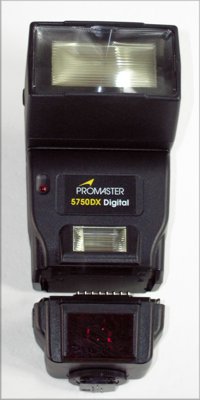
|
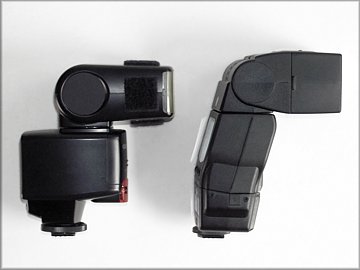
|
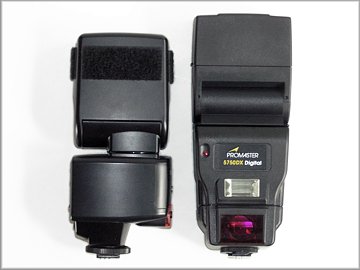
| |
| Size and shape comparison between Promaster 5750 DZ (right) and the Olympus FL-40 (left). | ||
|
Integration with the camera I'm glad I can report that all automated flash functions of the Promaster 5750 DX worked flawlessly with the four Olympus cameras I've tried it with: the E-10, E-20, C-5050Z, and C-5060WZ. I am sure they will work equally well with other Olympus models equipped with a hot shoe, most notably the '8080, and the E-1 (in the last case, without the multi strobe effect, used to synch at high focal-plane shutter speeds). There is also no doubt that the less expensive 5550 DX will co-operate with these cameras equally well, as both flashes use the same interface module. I've checked the flash functionality in the full auto (point-and-shoot) mode, as well as in aperture and shutter priority. In all cases I experienced no surprises, and the resulting images were properly exposed. The only exceptions were when I would take another picture before the unit was able to recharge; I was experiencing some underexposure in these cases. This is not a deficiency, however: if you are buying a flash like this, you are supposed to know what you are doing. Note: One of the Readers verified that the '5750 works with the C-2100 with use of the Olympus flash cable (which provides a dedicated hot shoe on the flash end, and a compatible plug on the camera end). Compatibility Warning: Olympus changed the flash control interface in its cameras around 2003, and the change is not upwards-compatible. While the E-1 works OK with flashes using both the old and the new version, the later SLRs (from the E-300 to E-510) will see the 5750 DZ as just a dumb, non-dedicated unit which defies the purpose of using it. As the flash-to camera interface is implemented in the dedicated module, this may chenge in the future, but so far (August, 2007) there is no information on that available. Sample images | |
|
This is a picture I'm taking to check the metering of bounced flash in mixed-light environment. The light is bounced of the ceiling and the wall of a narrow hallway. The shot was taken with the E-20 camera, results with others are quite similar. I consider the exposure to be just fine, and the color balance with mixed light is the responsibility of the camera, not of the flash itself. |

|
| Olympus E-20 and Promaster 5750 DX flash; programmed exposure at -0.3EV: 1/50s, F/2.2, ISO 80. Equivalent focal length: 72 mm. | |
|
The next pair of samples, taken with the C-5060WZ and E-20, shows the flash behavior in a medium-size interior, with a wide angle lens. | |
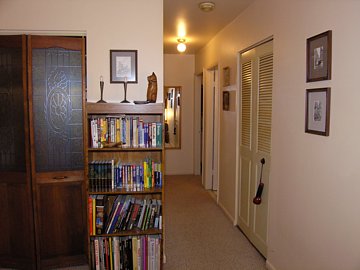
|
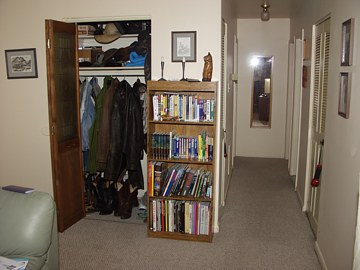
| |
| Olympus C-5060WZ and Promaster 5750 DX; program exposure at -0.3EV: 1/30s, F/4.0, ISO 400. EFL = 27 mm. | Olympus E-20 and Promaster 5750 DX; program exposure with no compensation: 1/30s, F/2.0, ISO 80. EFL = 35 mm. |
|
Both cameras exhibit quite a different behavior in terms of exposure and color balance (differences in the latter cannot be explained by the ceiling light being on in the first sample), but the flash in either case does, I believe, exactly what the camera wants it to do, and exposures are just fine. Interestingly, in the picture shot with the '5060 at EFL=27 mm I haven't used the diffuser, recommended for the flash head at this focal length. Still, the light fall-off is barely noticeable. Other checks (white wall shots) have shown that the uniformity of the Promaster flash is quite OK, if not spectacular; more than good enough for serious uses. Another of my standard subjects I'm using to check exposure accuracy: a row of books. The exposure seems to be right on the nose in both cases. |

|

| |
| Olympus C-5060WZ and Promaster 5750 DX; program exposure at -0.3EV: 1/100s, F/4.8, ISO 400; EFL = 110 mm. | Olympus E-20 and Promaster 5750 DX; program exposure with no compensation: 1/60s, F/2.2, ISO 80. EFL = 88 mm. |
|
(If you think the left sample is a bit fuzzy, you're right. This, of course, has nothing to do with the flash: the '5060 had problems focusing on this particular subject from this particular distance; four frames turned out this way. Changing the subject distance or tilting the camera to a side helps, as I could check.) Recommended In spite of my original doubts, the Promaster 5750 DX flash turned to be a capable performer with all Olympus cameras I've tried it with. Its integration with Olympus Camedia cameras leaves nothing to be desired, and the specs are quite generous, at par with those of the Olympus FL-40 and FL-50 flashes. The second burner is a nice bonus. While Olympus units have better "feel" and finish, they are twice as expensive, and these are not significant differences. Update of August, 2005: My recommendation for this unit became less enthusiastic recently, not because I discovered anything wrong with the flash itself, but because the new FL-36 from Olympus works perfectly well with all Olympus cameras mentioned here (E-10/E-20, C-5050Z, C-5060WZ), and it also has a motorized head, reacting to camera's zoom setting. This gives the FL-36 some advantage in integration with the camera, while the 5750 offers more light. Tough choice/ At $200 (compare this with $380 for the FL-50 at B&H, or $450 at most other stores) I consider the 5750 DX to be a very good buy, saving you lots of money without sacrificing any functionality, specs, or integration with the camera. The flash is not easy to find; I bought it at Wolfe's Camera (not to be confused with Wolf Camera which really is a subsidiary of Ritz Camera, a mass-market outlet). They are selling it at $200 (Olympus module included); the less expensive 5550 DX will save you $40 (no head zoom, no second burner). I do not know if Promaster flashes are available at all outside of the United States, under this or any other name. |

|

|

|
My other articles related to the Olympus E-System...
...or to to the C-5050Z, C-5060WZ, and C-7070WZ ...or to the Olympus E-10 and E-20 cameras |
| Home: wrotniak.net | Search this site | Change font size |
| Posted 2004/06/14; last updated 2007/08/05 | Copyright © 2004-2007 by J. Andrzej Wrotniak |